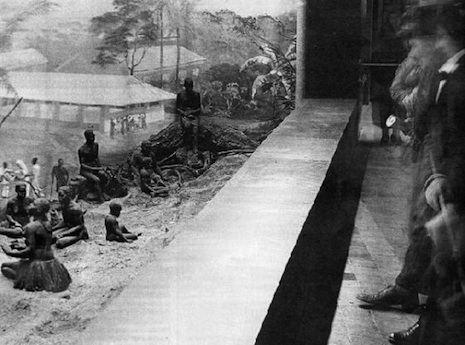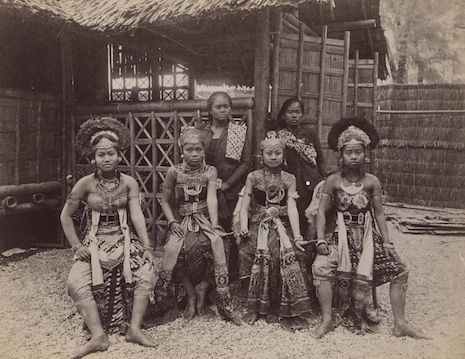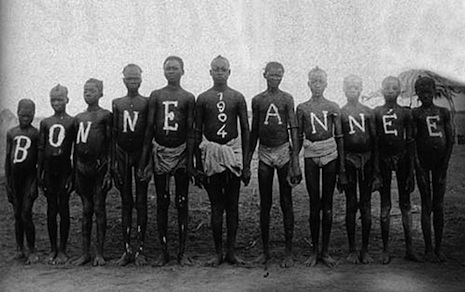
Brussels is the capital of Belgium. It is the major city within the nineteen municipalities that make up the Brussels-Capital Region.
Since the end of the Second World War, Brussels has been home to a large population of politicians, diplomats, civil servants, businesses and industrialists. It is closely tied to the European Union and has been dubbed the “de facto capital” of the European Union since the 1970s. It’s Europe’s Washington. DC.
Brussels is where the European Commission (that august government branch of the EU) and the Council of the European Union (the well-respected legislative body made up of those jolly executives of member states) are based. It is city that represents the humanitarian values of a civilized and prosperous Europe.
But wait.
Not so long ago, indeed within living memory, Brussels was the last bastion of a racist sideshow called the “human zoo.”
In 1958 Brussels held the first World’s Fair since the end of the Second World War. Between April and October of that year, the Exposition Universelle et Internationale de Bruxelles gave testament to the shared ideals of equality and fraternity, the innovation of industry and a very real humanitarian hope for a peaceful and prosperous future.
Among the many major exhibits at Expo 58 that celebrated this hope for a better world were the massive building-cum-sculpture the Atomium—or “load of balls” as some have since described it—designed by engineer André Waterkeyn and architects André & Jean Polak; and the Philips Pavilion where composer Edgard Varèse premiered his seminal eight minute work Poème électronique—which followed a naive and simplistic narrative of the development of life and civilization towards a universal “harmony.”
In amongst all these space age wonders and exhibits from countries across the world was the Belgian Pavilion. Here visitors could find all that was best about Belgium including one small enclosure where the public flocked to pet and feed the exhibits.
Look here comes one now. A middle-aged matron in finely cut dress, coat and hat, wearing early designer sunglasses. Doesn’t she look chic? Let’s watch as this no doubt charming woman leans over the fence that surrounds the enclosure to feed one of the humans inside—a small black girl.

Horrendous isn’t it? Shocking. Horrific. Unbelievable. Like some dystopian sci-fi movie.
But to the 41 million people who visited Expo 58 this scene of unbridled racism caused little concern to the public—no upset, and no fury. No nothing.
You’d think after the racist atrocities of the Second World War that maybe, just maybe, Europeans might have developed a little more respect for their fellow man. But no, apparently not.
Human zoos, where white Europeans could go and see people from other ethnic backgrounds exhibited in cages, or in specially built villages for entertainment purposes is one of the biggest, dirtiest, and most shameful racist “secrets” of European history. Which no amount of saying “the past is a different country, they did things differently there” will ever excuse.
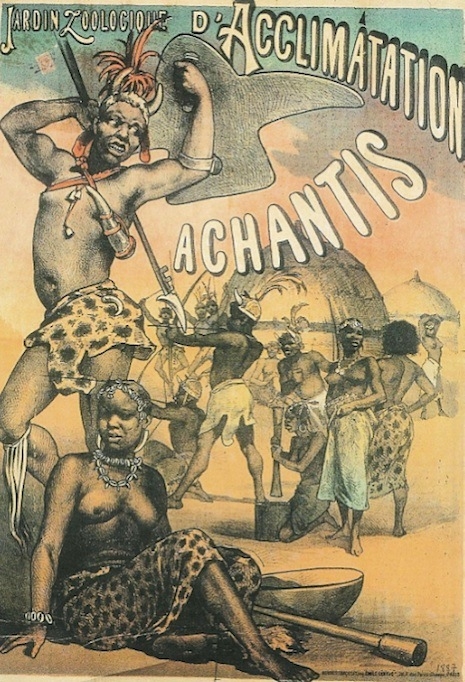
A poster advertising a ‘human zoo’ in Paris.
This wasn’t the Middle Ages. This was 1958. The year NASA was formed. The year the microchip was invented. The year the American Express card was introduced. When the hula-hoop was the #1 toy. When Elvis Presley joined the US Army. When Marilyn Monroe and Jayne Mansfield were the world’s pinups. When The Bridge on the River Kwai cleaned up at the Oscars and Steve McQueen terrified audience in his fight with The Blob. When the Yankees won the World Series and Brazil took the World Cup. The year the forerunner of the EU, the European Economic Community (EEC) was formed. This is within our pop culture timeline of rock ‘n’ roll, drugs and teenage rebellion. Your parents, grandparents, great-grandparents and great-great grandparents might even have attended themselves.
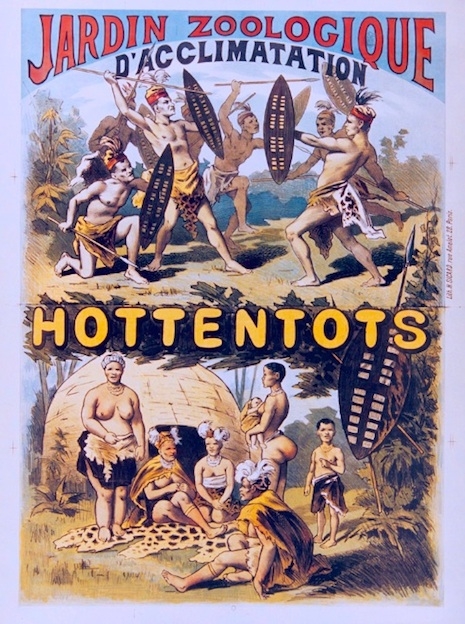
In Europe human zoos can be traced back to the sixteenth century when Cardinal Ippolito de’ Medici kept a “menagerie” of exotic animals and humans in the Vatican. He wasn’t the first—Montezuma II kept a zoo of “dwarves, albinos and hunchbacks.” What differentiated the two was color. Europeans chose people of different ethnic origin to exhibit in human zoos—or as they were known in France “Jardin Zoologique d’Acclimatation” or just zoos.
Human zoos were a way for white people to feel morally superior to blacks. How white people could justify their invasion and exploitation of other countries by claiming they were the “civilized” ones and that their victims not. How the rich of white society could appease the lower working classes by letting them benefit from some dubious moral well-being by ogling Hottentots, Pygmies, Zulus, Nubians, Bushmen, or Congolese in zoos. In fact ogling anyone white Europeans could exploit and feel superior to, by imprisoning them in cages.
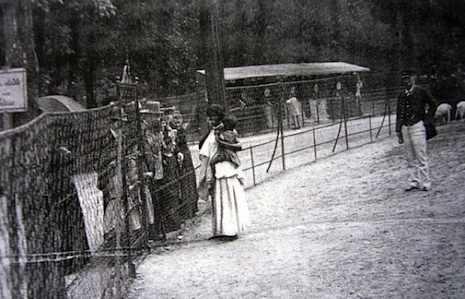
A zookeeper watches on as a young African mother and child talk to their spectators at a zoo.
This was state sanctioned racism. Justified by the ridiculous belief white Christians were superior to all other nations because they had heard “the Word” and had been saved. Alleluia! Crafty entrepreneurs—such as the bearded skull-faced Carl Hagenbeck—quickly saw the money-making potential in exhibiting families and whole villages of indigenous peoples.
Carl Hagenbeck (1944-1913) was a German merchant of animal stock for zoos. In 1874, he decided there could be a little money-spinning in exhibiting human beings. He therefore opened an exhibition of Samoans and Sami people (Finno-Ugric natives of Arctic area of Sápmi). The exhibition was a hit and he followed it with similar zoos filled with Nubians and Zulus.
In 1877, the Jardin d’acclimatation organized two “ethnological spectacles” presenting enclosures filled with Nubians and Inuit peoples. For these exhibitions, the zoo reached a record attendance of one million visitors.
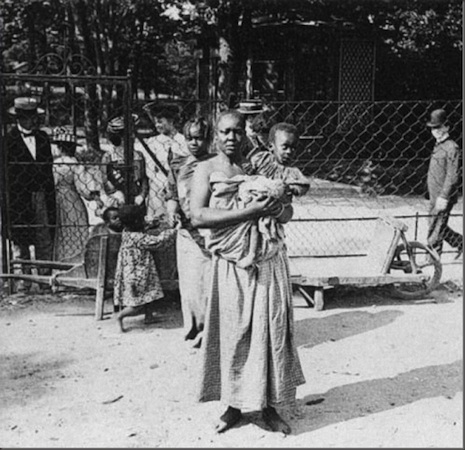
Throughout the late 1800s across Europe (Paris, Hamburg, Antwerp, Barcelona, London, Milan and Warsaw) and in New York, human zoos thrived—making the equivalent in today’s money of millions of dollars for their owners.
These human exhibitions were soon included in World Fairs. A negro village received star-billing at the Exposition Universelle in Paris 1899; the 1900 World fair included a diorama of native life in Madagascar; while the Colonial Exhibitions held in Marseilles in 1906 and 1922, and those in Paris held in 1907 and 1931 exhibited “humans in cages, often nude or semi-nude.”
These were not sideshows visited by curious and freak-seekers. These were major cultural and political events attended by royalty, politicians, the great and the good, and millions upon millions of the general public. Like the King Tut craze of the 1970s, or the recent “David Bowie Is” exhibition.
For example the Exposition coloniale internationale in Paris 1931 was attended by 34 million people during six months—with an estimated 7 to 9 million visiting from overseas. This little fact goes some way towards explaining how racism is spread and are reinforced in even the most “cultured” of settings. The effect on the mass public of seeing blacks paraded in cages or in animal enclosures only reinforced the worst kind of dangerous and ignorant racist beliefs.
“Ah,” you might say, “They didn’t know any better....” But they obviously did. That’s why indigenous natives were put in cages in the first place—to expiate any guilt from all the colonial raping, plundering, and killing that these various white countries carried out for their own personal profit and gain.
By reinforcing an artificial difference they created a very real psychological difference among white Europeans and white people in general—which let’s be honest, is still disturbingly apparent to this very day—and practically anyone else not Caucasian.
As a reminder to the horrors of human zoos, here are a few images of this grim, racist—and recent, historically speaking—reality. For if memory makes us who we are, then if we lose our memory—or our sense of history—we can never truly evolve.
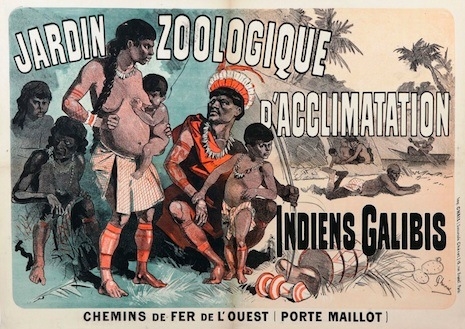
Poster for human zoo in Paris.
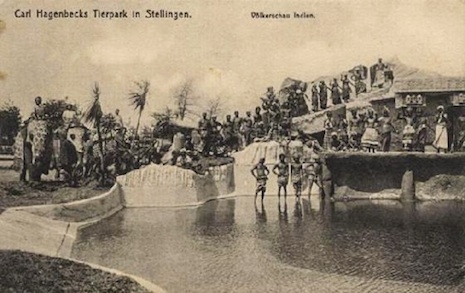
Postcard for ‘Carl Hagenbeck’s Zoo.’

The ‘Exposition Colonial’ pavilion at the World’s Fair 1903.
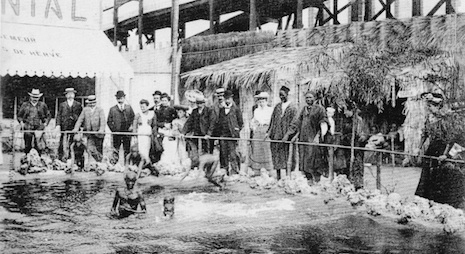
Visitors to a human zoo in Paris watch a man bathe in a pool.
